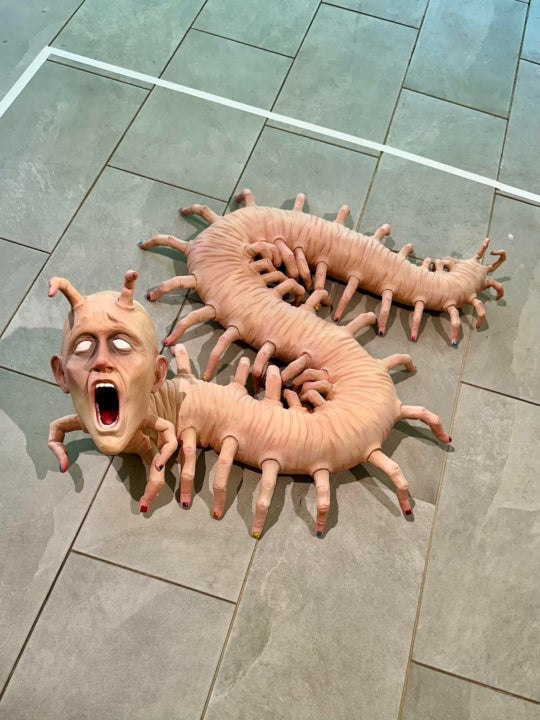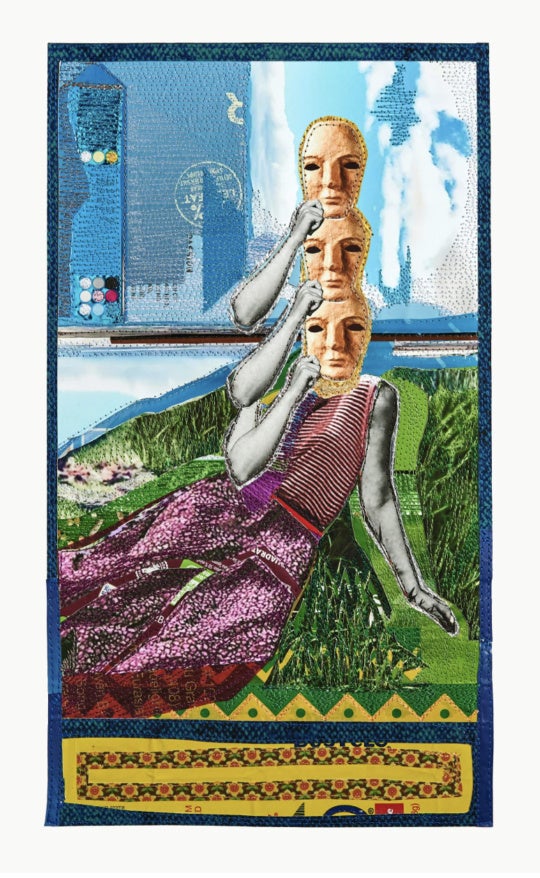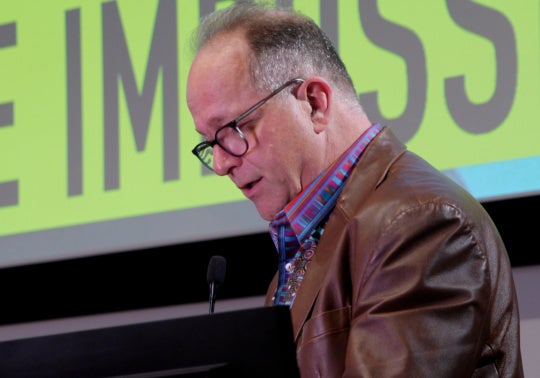
Imagine it’s the mid ‘90s in Atlanta. You’re at BLT’s Mostly Pizza, a college lunch spot that doubles as a nightly music venue featuring punk and noise bands such as Quadiliacha and Wheeljack. Now meet Ben Baumgartner, known as “Venom” to his friends—he’s the high school punk rocker sweating in the audience.
Fast forward to present day and Get This! Gallery replaces BLT’s, and Ben Baumgartner is now Ben Venom. Venom is now having his first solo exhibition in Atlanta in the same building he listened to bands some 15 years ago. His exhibition, boldly titled I Make No Mistakes, features a new selection of mostly large-format quilts, smaller quilted and machine-sewn works and embroidered denim jackets pulling from stereotypical metal imagery such as skulls, tattoos, spider webs, and thrash metal fonts.
Continuing threads and conceptual frameworks from past work, Venom explores the connections between heavy metal music and traditional quilting methods, with self-admitted references to the famous quilters of Gee’s Bend, Alabama, who were an initial inspiration.

Photo courtesy the artist and Get This! Gallery.
However, how does the conceptual conversation go beyond the initial collision of metal and quilting? This is a question, while not explicitly asked nor answered, that follows Venom’s work. Venom adopted this methodology during completion of his MFA at the San Francisco Art Institute in 2007, in the city where he still lives and works.
The installation is controlled and generous on space, which is important especially for the larger quilted works, the largest—a commanding presence—hangs at 5 x 9 feet. The main gallery space holds three new quilts. I Go Where Eagles Dare features a two-headed eagle and King of Kings depicts a griffin, both figures on black void-like backgrounds. The griffin is a mythological and legendary protective figure with the body of a lion and head of an eagle, used frequently in nationalistic flags or royal crests. Almost fittingly, heavy metal concerts have been compared to a sensory equivalent of war, described in Metalheads by psychologist Jeffrey Arnett.
But perhaps a more promising discussion is that, up close, Venom’s work almost warrants a connection to painting, something that would benefit from a slight push. Selections from individual units start to read as compositional forms. Some of the colorful and particularly graphic clippings show discernible references to horror films (the influence of stylized horror on metal and metal fashion is well established), as well as other contemporary artists. Could Venom’s quilts serve as machismo counterparts to the gooey, monstrous-feminine paintings and performances of Francine Spiegel, or perhaps an alternate sail to Matthew Day Jackson’s Sepulcher?

On the right, an all-denim quilt with the text Living On the Razors Edge (2012), an Iron Maiden lyric and subtle nod to Venom’s sewing practice, is composed of the faded knee-sections from denim jeans donated by friends. This quilt is in fact the only work in the exhibition that reads as quilt and landscape; the horizontal background knee-sections form the architecture to support the floating text.
Venom constructs his quilts from cut sections of heavy metal T-shirts, originally his own collection, but now mostly consisting of donations from friends and purchases online. But there are several other works in the show that do not involve T-shirt components at all. For example, two studded and embroidered black denim vests—Iron Hand and Slayer Player (both 2011)—contain imagery of militia and Russian prison gang tattoos and symbols. Venom uses the same embroiderers as the Hells Angels, though Venom’s denim vests nod more to punk and metal scenes as opposed the Angels’ leather counterparts.
While many find the conflation of these two perhaps disparate activities—heavy metal music and the act of quilting—as a dissonant union, it’s not too large a stretch to discuss them together, albeit a bit unexpectedly. Both quilting and the music genre have strong ties to a community identity. At a most basic level, they imply extremes (metal is hard and masculine while craft is soft and feminine) but do not necessarily deliver those extremes always. Both can border on kitsch—and hey, it’s no secret that most pioneers of heavy metal are now senior citizens themselves.
Heavy metal is known for attracting large fan bases but is often critically reviled. The majority opinion surrounding Venom’s work obsesses over this fusion of metal with quilting, which fearfully reads as one-dimensional analysis of his work and could in fact be criticism in disguise. It’s easy to make no mistakes following in your own tracks; such a conversation continually labels Venom as a one-trick-pony and thereby requests he leave the safety of his previous footprints and enter new territory. The question has to be asked: Will he deliver?
The exhibition I Make No Mistakes is on view at Get This! Gallery through October 6, 2012.




